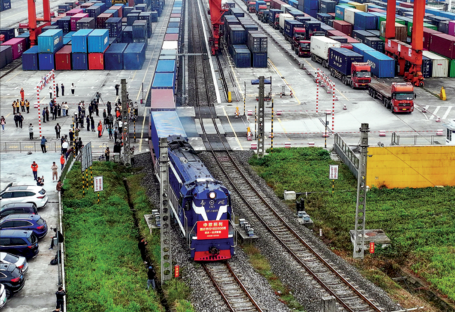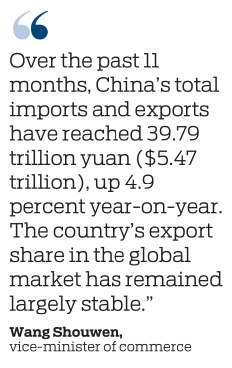
Automated vehicles deliver cargo at Qingdao Port's fully automated terminal in Shandong province on Dec 3.

A China-Europe Railway Express departs from Chongqing to Duisburg, Germany, on Nov 15.

Employees work on a photovoltaic module production line for export orders at a new energy technology company in Sihong Economic Development Zone, Jiangsu province, on Dec 2.

China will ramp up financial support, cultivate new growth engines, and strengthen services for foreign trade enterprises in order to unlock momentum and foster resilience in the country's foreign trade sector — a critical pillar underpinning overall economic growth, officials and analysts said.
As global trade faces strong headwinds and protectionist pressures, China is strengthening the coordination of its trade, fiscal, financial, and industrial policies to provide holistic support for enterprises in stabilizing orders and expanding markets, they added.
"Over the past 11 months, China's total imports and exports have reached 39.79 trillion yuan ($5.47 trillion), up 4.9 percent year-on-year. The country's export share in the global market has remained largely stable," Wang Shouwen, vice-minister of commerce, told a news conference in late November.
In recent years, the global economy has faced a backlash against globalization, with trade protectionism on the rise. Over the past decade, global trade growth has fallen behind global GDP growth, Wang said.
Foreign trade companies have said that the coverage of export credit insurance needs to be further expanded, smaller firms are facing certain financing difficulties, and they are also encountering bottlenecks in sea freight transportation, Wang added.
Against this challenging backdrop, China's foreign trade has maintained a stable growth trajectory. However, the country has seen a slight moderation in the pace of expansion since August, Wang said.
Foreign trade has been a bright spot in the Chinese economy over the past months, as sluggish domestic demand and a tepid property market have to some extent dragged down overall economic expansion, analysts said, calling for strengthened support in key areas.
Increasing financial support, and leveraging financial instruments to hedge against the uncertainties that enterprises may face, as well as reducing capital turnover cycles, are of utmost importance for foreign trade companies, especially smaller ones, said Zhou Maohua, a researcher at China Everbright Bank.
The Export-Import Bank of China will be tasked with strengthening credit allocation in the foreign trade domain. The bank will better tailor its financing products and services to meet the diverse needs of different types of trade enterprises, as laid out in the policy package introduced by the Ministry of Commerce.
Additionally, financial institutions across the board will be encouraged to increase lending to small and medium-sized foreign trade businesses in accordance with market-oriented and rule-of-law principles, according to the ministry.
Over the course of the year so far, the one year and five-year-plus loan prime rates have declined by 0.35 and 0.60 percentage point, respectively, according to the People's Bank of China, the country's central bank.
As a result, the weighted average interest rate on new corporate loans extended in September was around 3.5 percent — a 0.31 percentage point drop compared to the same period last year, reaching a historic low, said Liu Ye, an official at the central bank.
The central bank will also work to keep the renminbi exchange rate stable at an adaptive and balanced level, while strengthening guidance to prevent the market from tilting to one side, Liu said.
As part of the new initiative, dedicated efforts will be made to expand the scale and coverage of export credit insurance, aiming to empower enterprises in exploring more diversified overseas markets, according to a notice issued by the ministry.
Asia Best Partner Logistics, a company located in Shenzhen, Guangdong province, provides sea, land, and air transportation and has begun to transform its business to focus more on the cross-border e-commerce sector in recent years.
"In the past, our working capital was mostly self-funded. Due to the rapid growth of the international logistics market, our business volume has surged. In order to maintain operations, we had to give up some high-profit but longer-receivable businesses," said Chen Chunhong, head of the company.
In 2021, Bank of China's Shenzhen branch learned about Asia Best Partner Logistics' situation and adjusted its credit policy to provide the company with a dedicated 4 million yuan startup guarantee loan.
Building on this initial cooperation, in 2022 the bank further optimized its support, offering Asia Best Partner Logistics an 8 million yuan credit line along with international settlement and payroll services to address the company's frequent foreign exchange needs.
With the strong financial support, the company has signed premium airline routes, expanded its service offerings, and deepened partnerships with major export and e-commerce firms. Over the past three years, the company has achieved steady 30 percent annual growth on average, Chen said.
In addition to robust financial services, catalyzing the growth of the cross-border e-commerce sector is also high on the work agenda, and a key priority is the continued advancement of overseas smart logistics platforms, according to the Ministry of Commerce.
Meanwhile, the country will encourage local authorities to explore the establishment of cross-border e-commerce service platforms to provide enterprises with legal advisory, tax guidance, and other crucial business services for navigating overseas markets, the ministry added.
During the first three quarters of the year, China's cross-border e-commerce imports and exports grew by 11.5 percent year-on-year, accounting for nearly 6 percent of the country's total foreign trade, data from the ministry showed.
The rapid expansion of China's cross-border e-commerce sector underscores its growing significance in driving the overall growth of the nation's foreign trade, analysts said.
Lan Qingxin, a professor in the School of International Trade and Economics at the University of International Business and Economics, said that China's cross-border e-commerce has achieved significant breakthroughs in diversifying its foreign trade markets, with business in emerging economies growing rapidly.
A number of influential international e-commerce companies have emerged, and an efficient and smart global logistics network has been established, strengthening China's international competitiveness, Lan said.
While China's cross-border e-commerce sector has experienced rapid growth, it also faces a range of challenges and shortcomings that require attention.
Policies related to the cross-border e-commerce industry have further room for improvement, and some enterprises have only a vague understanding of compliance requirements. The digital infrastructure supporting the sector is still not fully developed, with online service platforms needing stronger functionalities, and Customs clearance processes still facing certain bottlenecks, Lan said.
To this end, the government will enhance demand-supply matching by facilitating connections between exporters operating businesses on cross-border platforms and overseas logistics providers, said Vice-Minister Wang.
The authorities will provide compliance training to help over 120,000 cross-border e-commerce enterprises, many of which are small businesses, and navigate Customs clearance, taxation, product quality, and intellectual property issues, Wang said.
China's foreign trade is heavily dependent on sea freight, with 95 percent of cargo volume transported through maritime logistics. The challenges faced by major shipping corridors this year, including the Red Sea, Suez Canal, and Panama Canal, have had a tangible impact on the international trade environment.
The next step is to facilitate matchmaking between local foreign trade companies and freight forwarding firms, enabling better alignment of demand and supply in the sea freight market, said Zhou Mi, a senior researcher at the Chinese Academy of International Trade and Economic Cooperation.
The government should also encourage shipping companies to develop online platforms to better cater to the booking needs of small and medium-sized enterprises, Zhou added.
Provincial-level regions with fairly large trade volume should take the lead in driving the implementation of these initiatives as they have a crucial role to play in stabilizing the overall foreign trade performance, Zhou said.
China's major economic powerhouses — Guangdong, Jiangsu, and Zhejiang provinces — have emerged as crucial engines propelling the country's foreign trade growth. During the first 10 months of the year, these three provinces recorded import and export value increases of 10.6 percent, 7.6 percent, and 7.1 percent year-on-year, respectively.
The success of these leading provinces in sustaining their foreign trade growth through the year-end sprint will be critical, as their strong performance has been a significant contributing factor to China's total foreign trade numbers, Zhou said.
wangkeju@chinadaily.com.cn

